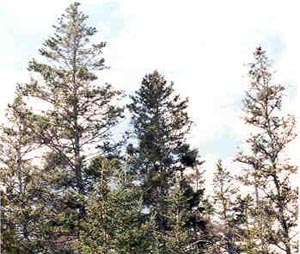DACF Home → Bureaus & Programs → Maine Forest Service →Forest Health & Monitoring → Forest Pest Index → Declining Spruce Health in Coastal Regions of Maine
Declining Spruce Health in Coastal Regions of Maine

Many spruce stands on the islands and headlands of coastal Maine are overmature and growing on poor sites. Most stands have not been managed to promote more vigorous tree growth. These factors combined with damage caused by several active spruce pests and the added stress of recent adverse weather conditions have significantly affected the health of coastal spruce.
The History of Coastal Spruce Stands
Red and white spruce constitute the predominant forest type on much of the central and eastern Maine coastline and offshore islands. During the 1800s many of these islands and headlands were cleared of the original spruce stands and used for agricultural, commercial, and residential purposes. In the early 1900s, island communities began to decline and many cleared areas reverted to forest. Some of the larger islands were logged extensively between 1930 and 1950, but little large scale harvesting has occurred since. Stands of large, overmature white and some red spruce persist in many previously cleared areas. White spruce out-competed the original red spruce on many sites. Regenerating coastal spruce trees, especially white spruce, grew very rapidly for 30 to 50 years in the moist and moderate maritime environment. However, most stands are now much older than 50 years. Without management to promote stand vigor, growth has stagnated. Many stands contain trees 60 to 120 years old, that exceed 15" in diameter, are 80 feet in height, and have grown very slowly for at least 20 years. Unfortunately, island and coastal sites have shallow rocky soils that limit tree growth and longevity. Because coastal spruce stands have exceeded the growth capacity of these sites they are now in decline.
Symptoms
Declining trees often have a sharply reduced foliage compliment with foliage clumped at the ends of branches and very little foliage near the bole. Foliage may have a yellowish or reddish cast. Tops of some trees appear bare and may have numerous dead or dying branches. Tree boles often show outward evidence of rot or disease and holes in the bark from woodborers, bark beetles, and woodpecker activity are common. Low vigor stands usually contain some large standing and fallen dead trees.
Causes of Declining Spruce Health
In addition to generally poor vigor, many coastal stands increasingly fall victim to pest organisms and climatic stress. Severe wind storms caused significant blowdown in coastal stands during 1991 and 1996. The majority of mature spruce stands on the Maine coast now contain some wind damaged areas that have created openings in the canopy and will increase the impact of future wind storms. Severe droughts in 1994 and 1995 caused added stress to spruce trees on shallow, ledgy sites. Pests affecting spruce vigor and survival include a recent outbreak of hemlock looper (a defoliator of fir and spruce), a high occurrence of dwarf mistletoe (a parasitic plant that weakens host trees), and an active infestation of spruce beetle (a native bark beetle that can kill healthy spruce). From 1990 to 1992 hemlock looper killed spruce trees in some stands and significantly stressed other spruces in coastal areas. Dwarf mistletoe is currently killing some spruce trees and weakening others. A spruce beetle outbreak that intensified in 1992 remains active and is killing a high percentage of the large spruce in several areas.
Coastal Spruce Management
Most of the agents killing or causing stress to mature coastal spruce have been exacerbated by the lack of stand management. Most agents affecting these stands have no effective control strategies. Trees are large, overmature, tightly spaced, and are on generally poor sites that can not support much additional stand growth. If nothing is done in these stands their age and maturity will result in a steady deterioration and eventual widespread tree mortality. Other stands will experience catastrophic mortality from events such as severe spruce beetle attack. For landowners who find these alternatives unacceptable, the only reasonable alternative is to restore and maintain long term stand vigor through ongoing stand management. Removal of large, old trees will be essential in many stands to promote new growth, but most areas already contain younger more vigorous trees and regeneration that should lessen visual impacts. Landowners interested in management of their coastal spruce stands should seek the advice of a licensed professional forester.
MAINE DEPARTMENT OF AGRICULTURE, CONSERVATION AND FORESTRY
Maine Forest Service - Forest Health and Monitoring Division - April 1997